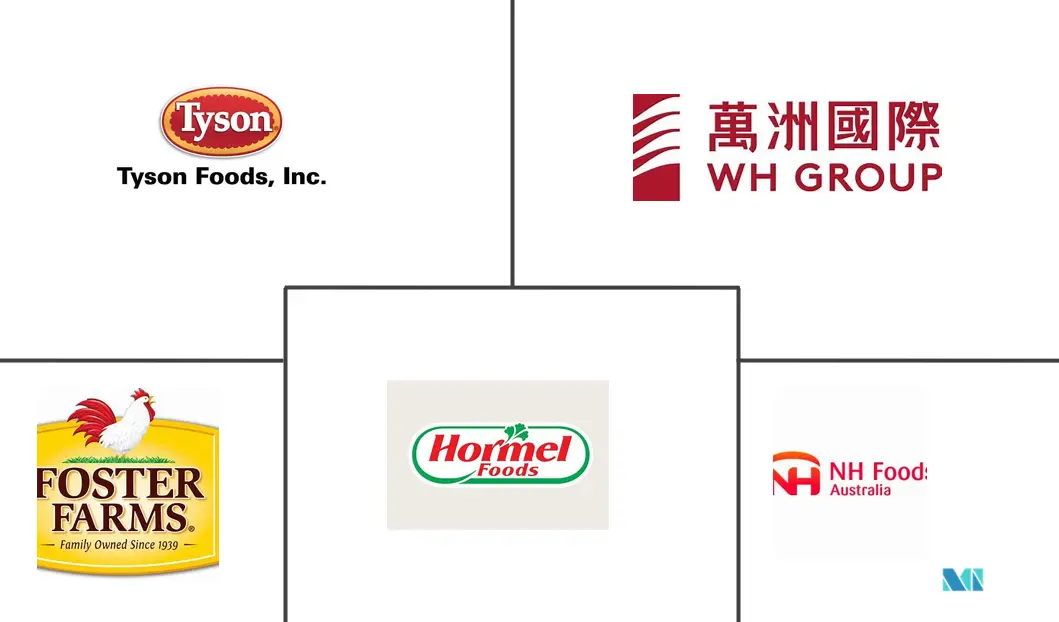Market Size of China Processed Meat Industry

| Study Period | 2019 - 2029 |
| Base Year For Estimation | 2023 |
| Market Size (2024) | USD 26.99 Billion |
| Market Size (2029) | USD 30.53 Billion |
| CAGR (2024 - 2029) | 2.50 % |
| Market Concentration | Low |
Major Players
*Disclaimer: Major Players sorted in no particular order |
China Processed Meat Market Analysis
The China Processed Meat Market size is estimated at USD 26.99 billion in 2024, and is expected to reach USD 30.53 billion by 2029, growing at a CAGR of 2.5% during the forecast period (2024-2029).
Chinese consumers consistently demand ready-to-cook and ready-to-eat meat products by maintaining super taste and premium quality. With the outbreak of the COVID-19 virus, the consciousness about health and fitness among the people has increased, and acceptance of convenience food products also increased, which drives the growth of the processed meat market in China. The food & beverages sector in China was the least damaged as consumers were vigorously purchasing processed foods such as frozen pork, beef, and other RTE food items from e-commerce websites as well as from supermarkets and hypermarkets at the time of the COVID-19 pandemic.
Furthermore, innovations in meat processing technologies due to higher consumption rates have led to the introduction of various products in the market that can simultaneously satiate the rising consumer demand and attract new consumers. China accounts for 49% of global pork consumption, with fresh and chilled processed beef being the highest selling beef item in China.
As modern trade channels continue to expand, demand for chilled and frozen pork is expected to rise rapidly in the forecast period. With rising modernization over the country, people are now turning toward western lifestyles, which tend to increase the consumption of bacon and ham items, which are low-temperature meat products. Hence, the rising consumption of pork and beef items with premium quality and deliciousness drives China's processed meat market. Chinese consumers are more concerned about food safety and consuming fresh food at reasonable prices; frozen beef has a considerable market share in China compared to chilled or fresh beef as it costs low.
China Processed Meat Industry Segmentation
Processed meat states to the meat that has been modified with curing, salting, smoking, fermentation, or other procedure to improve its taste and flavor or better preservation. China processed meat market is segmented by meat type into poultry, beef, pork, mutton, and others. By product type, the market is segmented into chilled, frozen, and canned or preserved meat products. Based on distribution channel, the market is segmented into hypermarkets/supermarkets, convenience stores, online retailing, and others. The report offers market size and forecasts for processed meat in Value (USD million) for all the above segments.
| By Meat Type | |
| Poultry | |
| Beef | |
| Pork | |
| Mutton | |
| Other Meat Types |
| By Product Type | |
| Chilled | |
| Frozen | |
| Canned/Preserved |
| By Distribution Channel | |
| Supermarkets/Hypermarkets | |
| Convenience Stores | |
| Online Retailing | |
| Other Distribution Channels |
China Processed Meat Market Size Summary
The China processed meat market is experiencing steady growth, driven by increasing consumer demand for ready-to-cook and ready-to-eat meat products that offer superior taste and quality. The market's resilience was evident during the COVID-19 pandemic, as the food and beverages sector remained robust, with consumers turning to processed foods like frozen pork and beef through e-commerce and retail channels. Innovations in meat processing technologies have introduced a variety of products to meet the rising demand, with China being a significant player in global pork consumption. The trend towards western lifestyles is boosting the consumption of low-temperature meat products such as bacon and ham, further propelling the market. Despite challenges like the African swine fever epidemic, which impacted pork prices, the demand for processed meat remains strong, supported by the country's status as a leading meat consumer.
The market is characterized by intense competition among major global and regional players, including Tyson Foods, WH Foods Limited, and Hormel Foods Corporation. These companies are expanding their presence through strategic partnerships with domestic players to enhance distribution and consumer reach. Online retailing is emerging as a rapidly growing sales channel, offering consumers the convenience of data-driven shopping experiences and attractive discounts. This shift towards online platforms is expected to significantly contribute to market growth. The competitive landscape is further shaped by acquisitions, such as Smithfield Foods' purchase of Mecom Group, which aims to increase production capabilities, and Hormel Foods' acquisition of Kraft Heinz's Planters, diversifying its product portfolio in the processed meat segment.
China Processed Meat Market Size - Table of Contents
-
1. MARKET DYNAMICS
-
1.1 Market Drivers
-
1.2 Market Restraints
-
1.3 Porter's Five Forces Analysis
-
1.3.1 Threat of New Entrants
-
1.3.2 Bargaining Power of Buyers/Consumers
-
1.3.3 Bargaining Power of Suppliers
-
1.3.4 Threat of Substitute Products
-
1.3.5 Intensity of Competitive Rivalry
-
-
-
2. MARKET SEGMENTATION
-
2.1 By Meat Type
-
2.1.1 Poultry
-
2.1.2 Beef
-
2.1.3 Pork
-
2.1.4 Mutton
-
2.1.5 Other Meat Types
-
-
2.2 By Product Type
-
2.2.1 Chilled
-
2.2.2 Frozen
-
2.2.3 Canned/Preserved
-
-
2.3 By Distribution Channel
-
2.3.1 Supermarkets/Hypermarkets
-
2.3.2 Convenience Stores
-
2.3.3 Online Retailing
-
2.3.4 Other Distribution Channels
-
-
China Processed Meat Market Size FAQs
How big is the China Processed Meat Market?
The China Processed Meat Market size is expected to reach USD 26.99 billion in 2024 and grow at a CAGR of 2.5% to reach USD 30.53 billion by 2029.
What is the current China Processed Meat Market size?
In 2024, the China Processed Meat Market size is expected to reach USD 26.99 billion.

